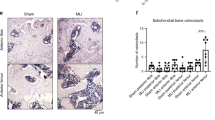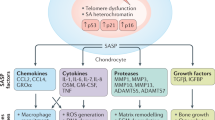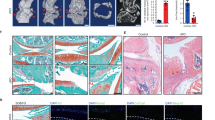Abstract
The extracellular matrix of articular cartilage is the primary target of osteoarthritic cartilage degradation. However, cartilage cells have a pivotal role during osteoarthritis, as they are mainly responsible for the anabolic–catabolic balance required for matrix maintenance and tissue function. In addition to the severe changes in the extracellular matrix, the cells also display abnormalities during osteoarthritic cartilage degeneration, such as inappropriate activation of anabolic and catabolic activities, and alterations in cell number through processes like proliferation and (apoptotic) cell death. The cells are exposed to additional stimuli such as nonphysiologic loading conditions and byproducts of matrix destruction, as well as abnormal levels of cytokines and growth factors. This exposure can lead to a structured cellular response pattern that may be either beneficial or detrimental to the cartilage tissue. Potentially even more problematic for preserving tissue homeostasis, neighboring osteoarthritic chondrocytes display strong heterogeneity in their phenotype, gene expression patterns, and cellular responses. As the disease progresses, osteoarthritic chondrocytes can no longer maintain tissue integrity. Evidence suggests that cell aging is important in the pathogenesis of osteoarthritis. Thus, anti-aging strategies might complement existing therapeutic targets related to anabolism, catabolism, inflammation, and apoptosis—processes that are integral to the pathogenesis of osteoarthritis.
Key Points
-
Osteoarthritic chondrocytes are exposed to many external factors and respond with a large spectrum of phenotypic and behavioral changes (anabolic, catabolic, proliferative, apoptotic, etc.)
-
Many of the biological changes occurring in osteoarthritic chondrocytes mimic the differentiation pattern that occurs during fetal skeletogenesis
-
The extraordinarily pleomorphic behavior of osteoarthritic chondrocytes suggests an unstructured/stochastic reaction pattern
-
Damage to the genome induced by oxidative damage and/or reactive oxygen species may be responsible for some of the so far unexplained heterogenous gene transcription patterns
-
Premature aging of chondrocytes might be important in the pathogenesis of OA
This is a preview of subscription content, access via your institution
Access options
Subscribe to this journal
Receive 12 print issues and online access
$209.00 per year
only $17.42 per issue
Buy this article
- Purchase on Springer Link
- Instant access to full article PDF
Prices may be subject to local taxes which are calculated during checkout




Similar content being viewed by others
References
Stockwell RA (1967) The cell density of human articular cartilage and costal cartilage. J Anat 101: 753–763
Aigner T et al. (2004) Aging theories of primary osteoarthritis—from epidemiology to molecular biology. Rejuvenation Res 7: 134–145
Middleton JFS et al. (1996) Insulin-like growth factor (IGF) receptor, IGF-1, interleukin-1b (Il-1b), and Il-6 expression in osteoarthritic and normal human cartilage. J Histochem Cytochem 44: 133–141
Middleton JFS and Tyler JA (1992) Upregulation of insulin-like growth factor I gene expression in the lesions of osteoarthritic human articular cartilage. Ann Rheum Dis 51: 440–447
Bau B et al. (2002) Relative messenger RNA expression profiling of collagenases and aggrecanases in human articular chondrocytes in vivo and in vitro. Arthritis Rheum 46: 2648–2657
Chubinskaya S et al. (1999) Expression of matrix metalloproteinases in normal and damaged articular cartilage from human knee and ankle joints. Lab Invest 79: 1669–1677
Duerr S et al. (2004) MMP-2/gelatinase A is a gene product of human adult articular chondrocytes and increased in osteoarthritic cartilage. Clin Exp Rheumatol 22: 603–608
Hayman DM et al. (2006) The effects of isolation on chondrocyte gene expression. Tissue Eng 12: 2573–2581
Homandberg GA et al. (1998) Cartilage damaging activities of fibronectin fragments derived from cartilage and synovial fluid. Osteoarthritis Cartilage 6: 231–244
Yasuda T and Poole AR (2002) A fibronectin fragment induces type II collagen degradation by collagenase through an interleukin-1-mediated pathway. Arthritis Rheum 46: 138–148
Aydelotte MB et al. (1986) Articular chondrocytes cultured in agarose gel for study of chondrocytic chondrolysis. In Articular Cartilage Biochemistry, 235–256 (Eds Kuettner K et al.) New York: Raven Press
Smith GN Jr (2006) The role of collagenolytic matrix metalloproteinases in the loss of articular cartilage in osteoarthritis. Front Biosci 11: 3081–3095
Sandy JD (2006) A contentious issue finds some clarity: on the independent and complementary roles of aggrecanase activity and MMP activity in human joint aggrecanolysis. Osteoarthritis Cartilage 14: 95–100
Glasson SS et al. (2005) Deletion of active ADAMTS5 prevents cartilage degradation in a murine model of osteoarthritis. Nature 434: 644–648
Stanton H et al. (2005) ADAMTS5 is the major aggrecanase in mouse cartilage in vivo and in vitro. Nature 434: 648–652
East CJ et al. (2007) ADAMTS-5 deficiency does not block aggrecanolysis at preferred cleavage sites in the chondroitin sulphate-rich region of aggrecan. J Biol Chem 282: 8632–8640
Song RH et al. (2007) Aggrecan degradation in human articular cartilage explants is mediated by both ADAMTS-4 and ADAMTS-5. Arthritis Rheum 56: 575–585
Aigner T et al. (1997) Suppression of cartilage matrix gene expression in upper zone chondrocytes of osteoarthritic cartilage. Arthritis Rheum 40: 562–569
Aigner T and Gerwin N (2007) Growth plate cartilage as developmental model in osteoarthritis research—potentials and limitations. Curr Drug Targets 8: 377–385
Aigner T et al. (1999) Reexpression of type IIA procollagen by adult articular chondrocytes in osteoarthritic cartilage. Arthritis Rheum 42: 1443–1450
Hambach L et al. (1998) Severe disturbance of the distribution and expression of type VI collagen chains in osteoarthritic articular cartilage. Arthritis Rheum 41: 986–996
Salter DM (1993) Tenascin is increased in cartilage and synovium from osteoarthritic knees. Br J Rheumatol 32: 780–786
Gebhard PM et al. (2003) Quantification of expression levels of cellular differentiation markers does not support a general shift in the cellular phenotype of osteoarthritic chondrocytes. J Orthop Res 21: 96–101
van der Kraan PM et al. (1998) Collagen type I antisense and collagen type IIA messenger RNA is expressed in adult murine cartilage. Osteoarthritis Cartilage 6: 417–426
Girkontaité I et al. (1996) Immunolocalization of type X collagen in normal fetal and adult osteoarthritic cartilage with monoclonal antibodies. Matrix Biol 15: 231–238
Merz D et al. (2003) IL-8/CXCL8 and growth-related oncogene alpha/CXCL1 induce chondrocyte hypertrophic differentiation. J Immunol 171: 4406–4415
Bau B et al. (2002) Bone morphogenetic protein-mediating receptor-associated Smads as well as common Smad are expressed in human articular chondrocytes, but not upregulated or downregulated in osteoarthritic cartilage. J Bone Miner Res 17: 2141–2150
Kaiser M et al. (2004) BMP- and TGFβ-inhibitory Smads 6 and 7 are expressed in human adult normal and osteoarthritic cartilage in vivo and differentially regulated in vitro by Il-1β. Arthritis Rheum 11: 3535–3540
Weiss C (1973) Ultrastructural characteristics of osteoarthritis. Fed Proc 32: 1459–1466
Hulth A et al. (1972) Mitosis in human articular osteoarthritic cartilage. Clin Orthop Relat Res 84: 197–199
Aigner T et al. (2001) Apoptotic cell death is not a widespread phenomenon in normal aging and osteoarthritic human articular knee cartilage: a study of proliferation, programmed cell death (apoptosis), and viability of chondrocytes in normal and osteoarthritic human knee cartilage. Arthritis Rheum 44: 1304–1312
Kim HA et al. (2000) Apoptotic chondrocyte death in human osteoarthritis. J Rheumatol 27: 455–462
Blanco FJ et al. (1998) Osteoarthritic chondrocytes die by apoptosis. Arthritis Rheum 41: 284–289
Martin JA et al. (2004) Post-traumatic osteoarthritis: the role of accelerated chondrocyte senescence. Biorheology 41: 479–491
D'Lima DD et al. (2001) Human chondrocyte apoptosis in response to mechanical injury. Osteoarthritis Cartilage 9: 712–719
D'Lima D et al. (2006) Caspase inhibitors reduce severity of cartilage lesions in experimental osteoarthritis. Arthritis Rheum 54: 1814–1821
Loeser RF et al. (2000) Reduction in the chondrocyte response to insulin-like growth factor 1 in aging and osteoarthritis: studies in a non-human primate model of naturally occurring disease. Arthritis Rheum 43: 2110–2120
Fan Z et al. (2005) Freshly isolated osteoarthritic chondrocytes are catabolically more active than normal chondrocytes, but less responsive to catabolic stimulation with Il-1β. Arthritis Rheum 52: 136–143
Dai SM et al. (2006) Catabolic stress induces features of chondrocyte senescence through overexpression of caveolin 1: possible involvement of caveolin 1-induced down-regulation of articular chondrocytes in the pathogenesis of osteoarthritis. Arthritis Rheum 54: 818–831
DeGroot J et al. (2004) Accumulation of advanced glycation end products as a molecular mechanism for aging as a risk factor in osteoarthritis. Arthritis Rheum 50: 1207–1215
Steenvoorden MM et al. (2006) Activation of receptor for advanced glycation end products in osteoarthritis leads to increased stimulation of chondrocytes and synoviocytes. Arthritis Rheum 54: 253–263
Loeser RF et al. (2005) Articular chondrocytes express the receptor for advanced glycation end products: potential role in osteoarthritis. Arthritis Rheum 52: 2376–2385
Billinghurst RC et al. (1997) Enhanced cleavage of type II collagen by collagenase in osteoarthritic articular cartilage. J Clin Invest 99: 1534–1545
Mitchell PG et al. (1996) Cloning, expression, and type II collagenolytic activity of matrix metalloproteinase-13 from human osteoarthritic cartilage. J Clin Invest 97: 761–768
Yudoh K et al. (2005) Potential involvement of oxidative stress in cartilage senescence and development of osteoarthritis: oxidative stress induces chondrocyte telomere instability and downregulation of chondrocyte function. Arthritis Res Ther 7: R380–R391
Martin JA et al. (2004) Effects of oxidative damage and telomerase activity on human articular cartilage chondrocyte senescence. J Gerontol A Biol Sci Med Sci 59: B324–B337
Hashimoto S et al. (1998) Linkage of chondrocyte apoptosis and cartilage degradation in human osteoarthritis. Arthritis Rheum 41: 1632–1638
Roach HI et al. (2004) Chondroptosis: a variant of apoptotic cell death in chondrocytes? Apoptosis 9: 265–278
Gebhard PM et al. (2004) Down-regulation of the GTPase RhoB might be involved in the pre-apoptotic phenotype of osteoarthritic chondrocytes. Front Biosci 9: 827–833
Aigner T et al. (2001) Anabolic and catabolic gene expression pattern analysis in normal versus osteoarthritic cartilage using complementary DNA-array technology. Arthritis Rheum 44: 2777–2789
Hall A (1998) Rho GTPases and the actin cytoskeleton. Science 279: 509–514
Liu AX et al. (2001) RhoB is required to mediate apoptosis in neoplastically transformed cells after DNA damage. Proc Natl Acad Sci USA 98: 6192–6197
Prendergast GC (2001) Actin' up: RhoB in cancer and apoptosis. Nat Rev Cancer 1: 162–168
Martel-Pelletier J et al. (2006) New thoughts on the pathophysiology of osteoarthritis: one more step toward new therapeutic targets. Curr Rheumatol Rep 8: 30–36
Pelletier JP et al. (2006) Most recent developments in strategies to reduce the progression of structural changes in osteoarthritis: today and tomorrow. Arthritis Res Ther 8: 206
Abramson SB et al. (2006) Prospects for disease modification in osteoarthritis. Nat Clin Pract Rheumatol 2: 304–312
Acknowledgements
This work was supported by the Deutsche Forschungsgemeinschaft (DFG Ai 20/7–1).
Author information
Authors and Affiliations
Corresponding author
Ethics declarations
Competing interests
The authors declare no competing financial interests.
Rights and permissions
About this article
Cite this article
Aigner, T., Söder, S., Gebhard, P. et al. Mechanisms of Disease: role of chondrocytes in the pathogenesis of osteoarthritis—structure, chaos and senescence. Nat Rev Rheumatol 3, 391–399 (2007). https://doi.org/10.1038/ncprheum0534
Received:
Accepted:
Issue Date:
DOI: https://doi.org/10.1038/ncprheum0534
This article is cited by
-
5-aminosalicylic acid suppresses osteoarthritis through the OSCAR-PPARγ axis
Nature Communications (2024)
-
LncRNA ZFAS1 protects chondrocytes from IL-1β-induced apoptosis and extracellular matrix degradation via regulating miR-7-5p/FLRT2 axis
Journal of Orthopaedic Surgery and Research (2023)
-
A Review of the Role of Bioreactors for iPSCs-Based Tissue-Engineered Articular Cartilage
Tissue Engineering and Regenerative Medicine (2023)
-
The role of apoptosis in the pathogenesis of osteoarthritis
International Orthopaedics (2023)
-
Amnion-Based Biomaterials for Musculoskeletal Regenerative Engineering
Regenerative Engineering and Translational Medicine (2023)



